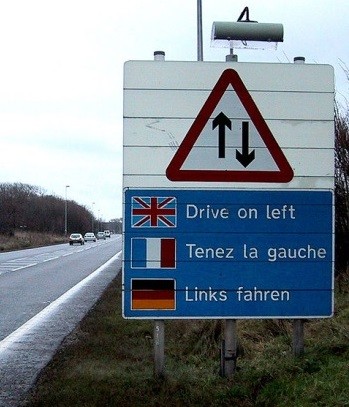Have you ever found yourself on a British road, slightly disoriented, wondering why cars are driving on the left side? It’s a question that perplexes many, especially those from countries where right-hand driving is the norm. The reason behind this seemingly unusual practice is deeply rooted in history, stretching back centuries to a time of swords and horseback travel.
The most commonly cited explanation takes us back to the Middle Ages. In those days, when traversing the countryside on horseback was the primary mode of transport, encountering strangers was a common occurrence, and caution was paramount. Since the majority of people are right-handed, riding on the left allowed a traveler to keep their right hand, the hand wielding their sword, free and ready to defend against any potential threats approaching from the right. This strategic positioning ensured that the sword arm was always closer to a passing stranger, facilitating a quicker draw if needed. This principle is also reflected in the design of Norman castles, where clockwise spiraling staircases favored right-handed defenders attacking downwards.
However, the tradition of keeping to the left arguably predates the medieval period. Archaeological evidence suggests that even the Romans, renowned for their road networks, directed carts and wagons to the left. Furthermore, Roman soldiers were known to march on the left side of the road. This ancient precedence indicates that the left-hand rule has remarkably deep historical roots.
The practice gained formal recognition in 1300 AD when Pope Boniface VIII decreed that all pilgrims traveling to Rome should keep to the left. This official sanction further solidified the custom across Europe for centuries.
The shift away from left-hand driving in some parts of the world began in the late 18th century, largely influenced by the advent of large wagons used for transporting goods. These wagons, often pulled by multiple pairs of horses, lacked a driver’s seat. Instead, the driver typically sat on the rearmost left horse to control the team, keeping their whip hand (usually the right) free. However, this left-side position made it challenging to judge oncoming traffic. This setup was particularly suited to the vast landscapes of Canada and the United States, and in 1792, Pennsylvania introduced the first keep-to-the-right law. Many other Canadian provinces and US states subsequently followed suit.
In France, a decree in 1792 mandated right-hand driving, a rule later reinforced by Napoleon across French territories.
Britain, however, did not experience the same pressures driving the shift to the right. The smaller vehicles common in Britain had driver’s seats. Given that most people are right-handed, drivers would sit on the right side of the seat, ensuring their whip hand remained free.
By the 18th century, increasing traffic congestion in London prompted the introduction of laws to manage traffic flow. London Bridge, a particularly congested point, mandated left-hand traffic to minimize collisions. This local rule was formalized and expanded in the Highway Act of 1835, applying the keep-left rule throughout the British Empire.
In the 20th century, there were movements to harmonize road laws across Europe, leading to a gradual transition from left to right-hand driving in many countries. Sweden was the last European nation to switch, making the change on “Dagen H” (H Day), September 3, 1967. On this day, at 4:50 am, all traffic in Sweden halted for ten minutes before resuming on the right side of the road.
Today, only about 35% of countries worldwide drive on the left. These include a diverse group of nations such as India, Indonesia, Ireland, Malta, Cyprus, Japan, New Zealand, Australia, and Samoa, which switched to left-hand driving in 2009. Many of these are island nations, and where left-driving countries share land borders with right-driving ones, traffic management solutions like traffic lights, crossover bridges, and one-way systems are implemented to ensure smooth transitions.
In conclusion, the British tradition of driving on the left is not arbitrary but a fascinating legacy of historical practices, evolving from medieval self-defense to practical adaptations in traffic management. While much of the world has shifted to the right, the UK and a number of other countries continue to drive on the left, a quirky reminder of a bygone era and a unique aspect of their cultural heritage.
